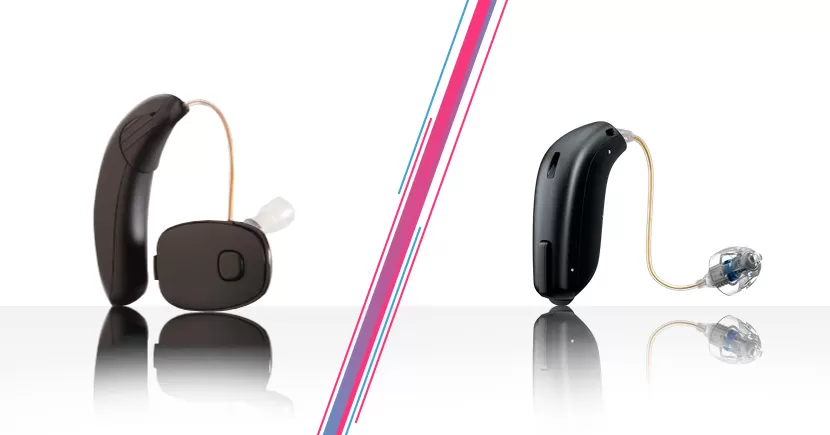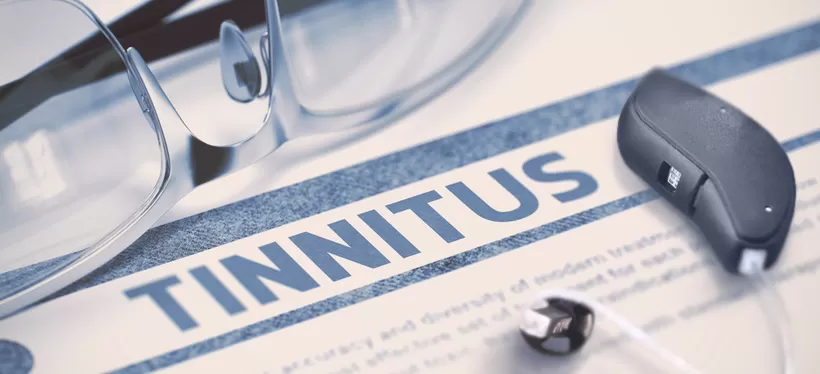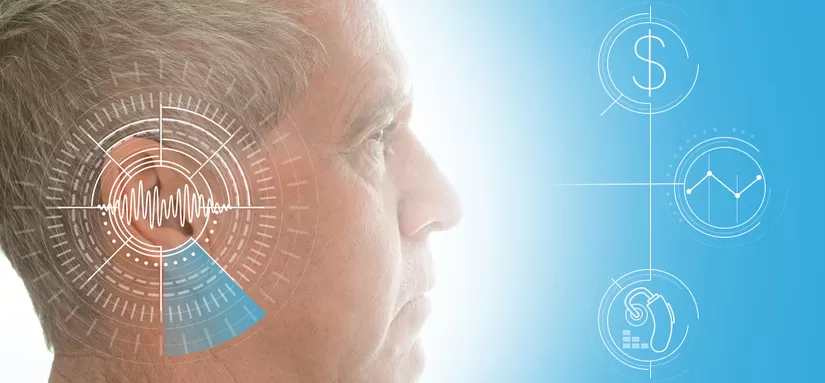Starkey Omega AI Hearing Aids Review & Features Explained (2025 Model)
On October 9, 2025, at its annual Starkey Days event in Eden Prairie, Minnesota, Starkey unveiled its newest flagship hearing aid: Omega AI. This model represents the company’s fifth generation of AI-powered hearing aids, replacing the Edge AI line and marking a major leap in both sound processing and user-focused design.
At the core of Omega AI is the new G3 Gen AI Neuro Processor, which powers DNN 360—a deep-neural-network-based directionality system. Unlike traditional directional microphones that focus only on sounds in front of the wearer, DNN 360 analyzes the entire sound environment to deliver more natural, 360-degree hearing.

Omega AI also expands Starkey’s wellness features, adding the industry’s first automatic respiratory-rate tracking and guided Balance Builder exercises available through the My Starkey app. Other updates include a more durable waterproof coating, LED status indicators, and longer battery life for reliable all-day performance.
Omega AI is available in six styles (shown below on this page), with rechargeable battery life ranging from 41 to 51 hours depending on the model. All versions support Bluetooth® LE Audio and are Auracast™ ready, offering broad compatibility for direct streaming and accessory use, including remote microphones and TV streamers (shown below on this page).
Core Tech and Features Explained
DNN 360
At the center of Starkey’s Omega AI platform is DNN 360, which Starkey describes as the first deep neural network–powered directionality system in a hearing aid. Unlike older systems that rely on fixed microphone rules, DNN 360 continuously analyzes your environment in real time. It listens for speech, picks up background noise, and tracks motion to decide how the microphones should behave.
Starkey claims DNN 360 delivers up to 28 percent better speech understanding and an 8 dB improvement in signal-to-noise ratio compared to previous models.
The system includes three key components:
- DNN Directionality, which focuses on speech when conversation is happening.
- DNN Spatial Awareness, which keeps your surroundings sounding natural when you are not actively engaged in speech.
- Motion-Based Optimization, which uses sensors to adjust microphone behavior when you are moving.
Together, these features allow the hearing aid to respond more like the brain. It adapts based on what you are doing and hearing, not just preset conditions.
Edge Mode+
These hearing aids do a lot of their own automatic adjustments, but sometimes it is not enough. For example, you walk into a noisy coffee shop with loud voices, hard surfaces, background music, and a barista wearing a mask. That is the kind of situation where Edge Mode + becomes useful. Originally introduced in the previous Edge AI model, the feature worked well enough that Starkey kept it unchanged in Omega AI.
Edge Mode + gives users a manual way to boost sound processing when extra help is needed. When activated, it re-analyzes the environment in real time and temporarily applies stronger settings for noise reduction, directionality, and compression, guided by the hearing aid’s deep neural network. Starkey describes it as unlocking reserve processing power for tough moments.
You can activate it through the My Starkey app, or with a button press if you are using the top-tier model. In my own use, I found that activating Edge Mode + made speech feel like it was lifted out from the background noise, almost like it was on a separate layer. The voices did not sound perfectly natural, but I could hear clearly without straining, which was the whole point. Starkey says this feature can improve signal-to-noise ratio by up to 13 decibels.
Generative AI Suite
Starkey’s new Generative AI Suite is a collection of (3) smart tools designed to make hearing aids more powerful and easier to live with, both for everyday users and for the professionals who support them.
TeleHear AI
TeleHear AI is a first of its kind feature. Think of it as a built-in support line that lives inside the My Starkey app, available 24/7. If something doesn’t sound quite right—maybe voices are too sharp or too tinny—you can simply describe the issue by typing into the app’s chatbox. TeleHear AI analyzes your feedback and makes instant adjustments to your hearing aids. It’s like having your hearing care provider in your pocket. If you don’t like the changes, no problem—you can undo them with a single tap. Just keep in mind that your provider has to enable the feature during your initial setup.
Starkey says that in testing, TeleHear AI reported 93 percent predictive accuracy and 84 percent user-reported benefit, showing that it’s not only fast and accessible, but also effective in helping users resolve common listening issues on their own.

Gen AI Smart Assistant
Gen AI Smart Assistant is a voice-controlled tool built into the My Starkey app. It’s a big step forward from the first-generation version introduced with Edge AI. This latest iteration responds faster, sounds more natural, and recognizes a wider range of everyday phrases. With simple voice commands, you can change programs, adjust volume, set reminders, ask questions, or even say “Where’s my phone?” to make your phone start ringing. It now understands natural speech with up to 93 percent accuracy, making it noticeably more intuitive and reliable than before.
That said, while it’s massively improved, it still has a long way to go before it becomes something most people will use routinely. Think of it as a promising early version of what voice-controlled hearing aids could become. At the moment, something like ChatGPT paired with AirPods is a far smoother conversational experience, but you can see where Starkey is headed—and it’s the right direction.
My take: every new wearer should have this feature enabled from day one. It’s the simplest way to learn how the hearing aids work and how to control them. You can treat it like your personal guide—any question you might normally ask your provider or have to Google, you can just ask the Smart Assistant first. It’s not perfect yet, but it’s already a genuinely useful companion for getting comfortable with the devices.
AI Assist
AI Assist is a tool working quietly behind the scenes within Starkey’s professional fitting software. While you won’t interact with it directly, it supports your hearing care provider during setup by offering real-time guidance and helpful information. It’s like your provider has a built-in version of ChatGPT inside the software, trained on Starkey’s documentation, ready to answer questions and provide support as they fine-tune your hearing aids. The goal is to make the fitting process more efficient and ensure your devices are precisely tailored to your needs from the very beginning.
Health Upgrades
Starkey’s Omega AI hearing aids push the boundaries of what hearing technology can do. Back in 2018, Starkey introduced fall detection in its Livio AI model, making it the first hearing aid to offer this safety feature. Then, with the previous-generation Edge AI, they added a built-in balance assessment tool to help monitor stability over time.
Now, Omega AI takes the next step with Balance Builder, which goes beyond monitoring by offering guided balance and coordination exercises in the My Starkey app—helping users actively improve their stability, not just track it. This evolution reflects a clear shift from reactive safety tools to proactive wellness support.

Omega AI also introduces the industry’s first automatic respiratory rate tracking, using built-in motion sensors to detect the small chest movements that occur while at rest. Because resting respiratory rate is one of the body’s key vital signs, tracking it provides valuable insight into overall wellness. Combined with Starkey’s existing tools like activity tracking and fall alerts, these updates show a clear evolution toward more comprehensive, everyday health monitoring—delivered through the hearing aid you're already wearing.
Acoustic Model Optimization 2.0
Acoustic Model Optimization 2.0 is a behind-the-scenes upgrade that helps hearing professionals fit Omega AI faster and more precisely than ever before. It uses in-ear acoustic data gathered during setup to build a model of your ear canal’s unique shape and resonance, allowing the hearing aids to automatically fine-tune themselves for a more accurate first fit—up to 10× faster than before.
Ideally, your provider wouldn’t need this feature because they’d be using real-ear measurement (REM) to calibrate your hearing aids precisely. But many clinics don’t have REM equipment, so it’s great that Starkey is giving professionals another tool to get closer to that level of personalization. You can think of it as a kind of “REM-lite,” helping reduce the back-and-forth office visits that can sometimes be needed to get new hearing aids dialed in. That was one of the drawbacks our YouTuber Nick mentioned in his review of the previous Edge AI model, and my hope is that between this feature and TeleHear AI, we’ll see fewer of those follow-ups. We’ll find out soon—subscribe to our channel to see Nick’s full Omega AI review when it’s released.
How it looks, fits, and feels
Dimensions (LxWxD): 26.6mm x 7.6mm x 12.6mm
Weight: 2.19g
The style I tested was the mRIC R, which is Starkey’s most popular version of this hearing aid and the one shown in 3D at the top of this page. It’s one of the smallest prescription hearing aids on the market, and also the lightest—I weighed it myself. You can choose from seven color options to help match your hair or skin tone. The pair shown below is in Chestnut Brown, which I picked to blend naturally with my hair color.

In use, it feels incredibly comfortable, lightweight, and discreet. Most premium hearing aids today check those boxes, but it’s still worth calling out just how unobtrusive this one is. A few times during testing, I tapped my ear to use the double-tap control and realized I hadn’t even put the hearing aid in yet. That’s how light it is.
How good is Omega AI?
We don’t have the final answer just yet, but we will soon. And when we do, this page will feature more reviews from real wearers than any other site on the internet.
Still, there are already a few things we can say with confidence:
It’s an upgrade over Edge AI, which was already excellent.
In our two-part video series comparing Edge AI to its two biggest competitors (Oticon Intent and Phonak Sphere), I picked Edge AI as the hearing aid I would personally buy. It performed incredibly well against two of the most advanced models available. Starkey has made tangible improvements to Omega AI, including one feature we specifically called out as missing in Edge AI: an LED indicator light. Based on what we’ve seen so far, Omega AI is shaping up to be an elite hearing aid.
Starkey’s leadership is showing real confidence — and welcoming transparency.
Not every hearing aid manufacturer is eager to hand over their latest product for independent testing. But Starkey is encouraging it.
HearAdvisor, the independent testing lab known for its unbiased hearing aid reviews, will be putting Omega AI through its usual rigorous analysis. And according to HearAdvisor cofounder Abram Bailey, AuD, Starkey’s president Brandon Sawalich didn’t just approve the testing — he welcomed it.
“I was completely taken aback by his confidence in the new Omega hearing aids, and his desire to get them tested by the lab. He was also welcoming of the lab bringing transparency to the industry, generally.”
– Abram Bailey, AuD, co-founder of HearAdvisor
That level of openness is rare in this industry, and it speaks volumes.
Detailed Omega AI expert review coming soon
Our YouTuber and hearing aid wearer, Nick, is currently putting Omega AI through its paces in the real world. He’s testing it in everyday environments, comparing it directly to Edge AI, and stacking it up against all the other top models he’s reviewed over the years.
A full video breakdown is coming soon to our YouTube channel. Subscribe now so you don’t miss it — and be the first to get an honest, detailed look at how Omega AI really performs.
Starkey Omega AI Pros & Cons
Pros
Edge Mode+ still delivers where it counts. Just like its predecessor, Edge AI, Edge Mode+ remains one of Starkey’s standout features. In challenging environments—think noisy restaurants or crowded gatherings—it can dramatically enhance speech clarity. Yes, the sound may lose a bit of its natural tone when the algorithm is working overtime, but for most users, that’s a small price to pay for easier, more comfortable conversations.
Fewer back-and-forth visits to the provider. Starkey’s updated Acoustic Model Optimization 2.0 and TeleHear AI tools make a noticeable difference in getting things dialed in faster. In Nick's original Edge AI review, he noted the need for multiple fine-tuning appointments. With these new upgrades, users can now enjoy a more streamlined fitting process—and even make minor adjustments themselves—reducing the need for in-person visits.
The most forward-looking hearing aid on the market. From DNN 360 to Starkey’s new Generative AI Suite, Omega AI doesn’t just match the competition—it leapfrogs it. Add in features like fall detection and the new Balance Builder, and it’s clear that Starkey is aiming to redefine what a hearing aid can be. This is the most technologically ambitious device currently available, and it shows.
The return of the indicator light. It might seem like a minor thing, but for many users (and providers), the absence of a simple status light on Edge AI was a frustration. Starkey heard the feedback. Omega AI brings back the indicator light, offering a quick visual cue for battery life, Bluetooth connectivity, and even helping you locate a misplaced aid. Sometimes, it’s the little things that make everyday use easier.
Cons
Rapid product cycles may leave recent buyers behind. Traditionally, hearing aid manufacturers stick to a release cycle of about 18 to 24 months. But as more innovation shifts to software and deep neural networks, we’re starting to see that window shrink. With the release of Omega AI, Starkey becomes the second major brand this year to launch a flagship update just over a year after their last. That’s exciting for tech lovers, but it can be frustrating for folks who just invested in devices like Edge AI. It feels like existing owners should at least have access to some of these new features—maybe through a free or discounted upgrade path—especially when their devices are still relatively new.
(Maybe) more to come. Be sure to subscribe to our Youtube channel, as Nick is putting these aids through their paces and may identify some areas of improvement. You may also want to bookmark this page, as very shortly we will have more Omega AI user reviews than any site on the web.
Conclusion
With Omega AI, Starkey is pushing hearing aids far beyond the traditional goal of simply making sound more audible. This feels more like a smart sensor platform you wear, a step toward the company’s vision that “the ear is the new wrist.” Several of the biggest frustrations we and many users had with the previous generation have now been addressed: fewer fitting appointments should be needed, a much-improved voice assistant, and the return of the indicator light. Starkey is clearly taking a more holistic approach to AI than any other manufacturer, building tools for both users and providers, not just layering on new features for marketing’s sake.
What stands out most is Starkey’s pace of iteration. Look at their health features alone: fall detection in 2018, fall-risk assessment with Edge AI in 2024, and now fall prevention with Balance Builder. That is a billion-dollar company innovating like a startup, fast, bold, and unafraid to test new ideas. As more sensor data (breathing, balance, motion) feeds back into generative AI systems, we may reach a point where your hearing aids predict your needs and adjust before you even notice. Starkey seems intent on getting us there first, and if they keep this trajectory, hearing aids could soon become something people want to wear, not something they have to.


















->getDescriptorURL()?>)

































![Buying Hearing Aids Online [Pros & Cons, Tips] Preview for the "Buying Hearing Aids Online [Pros & Cons, Tips]" video](https://cdn.ziphearing.com/dist/dynamic/files/videos/8/thumbnail/version/1/80/thumbnail.jpg)

![Rechargeable Hearing Aids [Pros & Cons] Preview for the "Rechargeable Hearing Aids [Pros & Cons] " video](https://cdn.ziphearing.com/dist/dynamic/files/videos/20/thumbnail/version/1/80/thumbnail.jpg)















